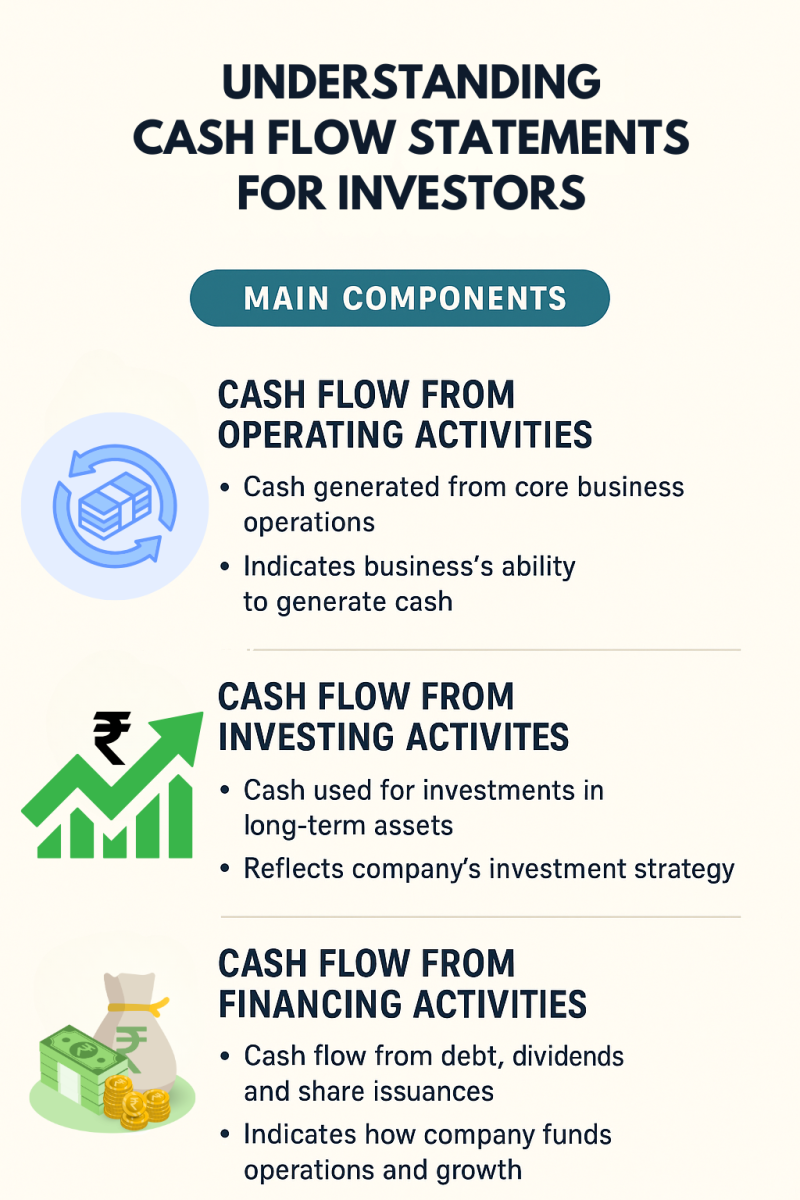
Understanding Cash Flow Statements for Investors
Understanding Cash Flow Statements for Investors
When evaluating a company for investment, many beginners focus only on revenue or net profit. However, profits don’t always mean strong financial health. A company may look profitable on paper yet still struggle to pay salaries, suppliers, or debts.
Thank you for reading this post, don't forget to subscribe!This is where the Cash Flow Statement becomes essential.
It shows how actual cash moves in and out of the business, helping investors understand the company’s liquidity, operational efficiency, and overall financial strength.
What is a Cash Flow Statement?
A Cash Flow Statement tracks how much cash the company generates and spends during a specific period.
It is usually divided into three key sections:
-
Cash Flow from Operating Activities (CFO)
-
Cash Flow from Investing Activities (CFI)
-
Cash Flow from Financing Activities (CFA)
Unlike the income statement (which includes non-cash items), the cash flow statement focuses only on real cash movement.
1. Cash Flow from Operating Activities (CFO)
This section shows the cash generated through the company’s core business operations.
Healthy Sign: Positive & Growing CFO
If a company consistently brings in positive cash from operations, it means:
-
Its business model is strong
-
Customers are paying on time
-
The company can sustain itself without external borrowing
Red Flags:
-
CFO is negative despite profits → company may be borrowing to stay afloat.
-
CFO is declining every year → core business weakening.
Example:
| Company | Profit | CFO | Interpretation |
|---|---|---|---|
| Company A | ₹120 Cr | ₹130 Cr | Strong operations; good sign |
| Company B | ₹150 Cr | ₹ –20 Cr | Profits not converting to cash → high risk |
2. Cash Flow from Investing Activities (CFI)
This section shows cash used for buying or selling long-term assets, such as:
-
Land or buildings
-
Machinery
-
Acquisitions
-
Investments in other firms
Healthy Sign:
-
Negative CFI is often good → means company is investing for growth.
Caution:
-
If CFI is negative and CFO is weak → company may be borrowing heavily to fund expansion.
Example:
A growing manufacturing company might show:
-
CFO: +₹200 Cr
-
CFI: –₹150 Cr
→ Indicates reinvestment into new factories — growth-oriented.
3. Cash Flow from Financing Activities (CFA)
This section reflects funding and repayment activities, such as:
-
Loans taken or repaid
-
Equity issued
-
Dividends paid
Healthy Sign:
-
Company reduces debt → financial strength.
-
Dividends paid → confidence in cash position.
Red Flags:
-
Constant borrowing → liquidity stress.
-
Frequent equity dilution → shareholder value erosion.
Example:
If a company frequently issues new shares:
→ Existing shareholders’ percentage ownership decreases.
How to Interpret the Whole Statement Together
| Scenario | Interpretation |
|---|---|
| CFO +ve, CFI –ve, CFA neutral/–ve | Best Case: Healthy business with reinvestment and reducing debt. |
| CFO –ve, Profits +ve | Profits are likely accounting adjustments → Risky. |
| CFO +ve but CFI small/0 | Company may not be investing for growth → Saturation. |
| CFA +ve & CFO –ve | Company is borrowing to survive → Avoid. |
Real-World Example (Simplified)
Suppose a company reports:
-
Net Profit: ₹100 Cr
-
CFO: ₹130 Cr
-
CFI: ₹–80 Cr
-
CFA: ₹–30 Cr
Interpretation:
-
Strong business operations
-
Investing back into growth
-
Reducing debt or paying dividends
Financially healthy and stable company
Why Cash Flow Matters More Than Profit
| Profit | Cash Flow |
|---|---|
| Can be influenced by accounting adjustments | Reflects real money |
| Doesn’t always show liquidity | Shows if the company can meet obligations |
| Good for valuation | Good for judging survival & efficiency |
If profit is the theory, cash flow is the reality.
Key Takeaways for Investors
| Focus Area | What to Check | Good Sign |
|---|---|---|
| CFO Trend | Is it increasing over years? | Steady + positive |
| Operating Cash vs Net Profit | Are both aligned? | CFO ≥ Net Profit |
| CFI Pattern | Is company investing wisely? | Negative but strategic |
| Financing dependence | Is company borrowing too much? | Minimal debt reliance |
Final Thoughts
The Cash Flow Statement is one of the most powerful tools for evaluating a company’s true financial health.
By learning to read it, investors can avoid companies that look profitable but are actually struggling — and identify those that generate real, sustainable value.
Before buying any stock, always check its cash flow trend for at least 3–5 years.
Related Blogs:
Understanding the Income Statement: A Beginner’s Guide
How to Read a Company’s Balance Sheet Before Investing
What Is Fundamental Analysis? A Beginner’s Guide
Disclaimer: This blog post is intended for informational purposes only and should not be considered financial advice. The financial data presented is subject to change over time, and the securities mentioned are examples only and do not constitute investment recommendations. Always conduct thorough research and consult with a qualified financial advisor before making any investment decisions.


